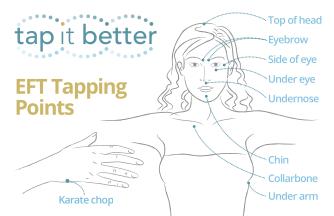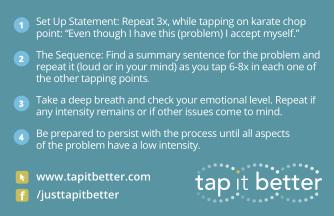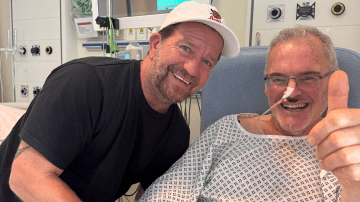Do you ever feel like your head will explode with so much to think about and get done? Do you find it hard to focus, and jump around from task to task, not making noticeable progress in any one of them? Or perhaps you feel irritable, anxious, depressed – or are in physical pain. All of the above may be symptoms of stress.
Today, as part of International Stress Awareness Week, Mental Wellness Coach Yolanda Saez Castello explains how Tapping could help you alleviate these symptoms and manage your stress or anxiety.
Busy work lives, young families, elderly relatives to care for, financial stress, housing worries and excessive workloads can all mount up and feel like a lot to manage. It is little wonder that your body and your mind will often end up feeling stressed.
While the societal changes required to address much of the above far exceed the content of this article, there are things you can do to help yourself; one proven way to help you through it all is using Emotional Freedom Techniques, aka EFT Tapping, which you can self-administer, and often reap immediate rewards.
For almost 10 years Tapping has helped my professional clients smash through their stress and anxiety so that they can achieve what they have set their heart on and live the life they deserve. Read on and it might help you too.
What is EFT Tapping?
EFT is a well-established intervention that is evidence-based as recognised by the American Psychology Association. It is also mentioned as highly cost-effective in the United Kingdom NICE guidelines, in this case specifically for Post-Traumatic Stress Disorder. You will be glad to read no needles are required, as the process involves tapping on acupuncture points on your face and torso, which sends powerful calming signals to the brain. It can be highly effective to help with stress, anxiety, trauma, depression and much more.
What is the science behind it?
Randomised controlled trials published in peer reviewed journals show that Tapping can reduce cortisol (the primary stress hormone) by as much as 43% in one group session only, as well as decreasing amygdala activation, i.e. reducing blood flow to the stress centre of your brain. The freed-up blood flow can then be used in other parts of your brain, like your frontal lobe for clear thinking.
Quite apart from the far-reaching implications of a drop in cortisol, other physiological markers proven to improve include a 51% drop in pain levels, a 74% drop in food cravings and a 113% increase in IgA, your immune system’s first line of defence, amongst many others.
How do you do Tapping?
Simple. Just tap gently with one or two fingertips, on the acupuncture points shown in the diagram, while focusing on the feeling.
If you would like to, you may follow this suggested protocol:
- Give your feeling an intensity number from 0 to 10 – but avoid tapping on anything that would be considered severe, as that would require working
with a practitioner in order to keep you safe.
- Start tapping on the outer side of your hand, thinking or saying out loud, ideally 3 times, “Even though I have this (feeling, i.e. stress, nerves, worry,
overwhelm), I will keep tapping and see if I can feel better”. - Then find a summary sentence, (“this stress”) and keep repeating it out loud or in your mind while you tap the rest of the points as per the illustration.
- After a couple of rounds, check your intensity, then continue to tap on any remaining feeling. Be prepared to persist for a few minutes until you feel
calmer, happier, or ready to enter that meeting room!
How can Tapping help your stress?
By appeasing the fight-or-flight response, tapping can facilitate more settled, positive or creative thinking; this, in turn, will induce calmer feelings, with increased clarity and focus, and potentially affect the outcome of a given situation; you might find you feel better able to cope, be more productive – or even hurt less as your cortisol drops.
Can you do it wrongly?
No, you cannot. If in doubt, simply feel the feeling and do the tapping. Keep it simple and keep it honest, and you are likely to see the intensity of your feelings decrease, potentially quite rapidly.
What are some practical examples?
Based on real-life client cases, here are some set up phrases you might use as orientation in similar situations:
- Public speaking nerves: “Even though I am so nervous about my talk today…”, then “these nerves…”
- Racing thoughts: “Even though my mind is racing so much right now…”, then “this racing mind…”
- Difficulty making decisions: “Even though I can’t see how to decide on this…”, then “this tricky decision”
- Exam nerves (use it before revising as well as on exam day): “Even though I have so much to revise and am nervous…”, then “these exam nerves…”
Why not give it a go? Happy Tapping.
Yolanda Saez Castello MSc is a Mental Wellness Coach and Advanced Tapping Practitioner trained to a level only achieved by a few hundred of her peers globally. She works one-on-one online from Jersey with clients the world over and has introduced her combined Tap It Better approach into schools and boardrooms alike. She offers very popular “Keep Calm and Tap It Better” and “Boost Your Resilience” workshops, which were created for the London Business School community, of which she is an alumna.
You can follow Yolanda on LinkedIn, on Facebook, or join her free FB group Freedom From Stress (FFS – I know!).
If you’d like a free 30 min chat with her, you may help yourself to a free slot here.
This article is not intended as a substitute for the medical advice of doctors. The reader should regularly consult a doctor in matters relating to their health and particularly with respect to any symptoms that may require diagnosis or medical attention.
Click here to go to our Wellbeing section…
… and click here to subscribe to our daily newsletter – meaning you will never miss a thing.














